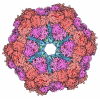[English] 日本語
 Yorodumi
Yorodumi- PDB-7ffn: Cryo-EM structure of VEEV VLP-LDLRAD3-D1 complex at the 5-fold axes -
+ Open data
Open data
- Basic information
Basic information
| Entry | Database: PDB / ID: 7ffn | ||||||
|---|---|---|---|---|---|---|---|
| Title | Cryo-EM structure of VEEV VLP-LDLRAD3-D1 complex at the 5-fold axes | ||||||
 Components Components |
| ||||||
 Keywords Keywords | VIRUS LIKE PARTICLE/PROTEIN BINDING / Virus / Receptor / Complex / VIRUS LIKE PARTICLE / VIRUS LIKE PARTICLE-PROTEIN BINDING complex | ||||||
| Function / homology |  Function and homology information Function and homology informationtogavirin / T=4 icosahedral viral capsid / regulation of protein processing / receptor-mediated endocytosis / amyloid-beta binding / symbiont-mediated suppression of host toll-like receptor signaling pathway / clathrin-dependent endocytosis of virus by host cell / host cell cytoplasm / symbiont-mediated suppression of host gene expression / serine-type endopeptidase activity ...togavirin / T=4 icosahedral viral capsid / regulation of protein processing / receptor-mediated endocytosis / amyloid-beta binding / symbiont-mediated suppression of host toll-like receptor signaling pathway / clathrin-dependent endocytosis of virus by host cell / host cell cytoplasm / symbiont-mediated suppression of host gene expression / serine-type endopeptidase activity / fusion of virus membrane with host endosome membrane / viral envelope / virion attachment to host cell / host cell nucleus / host cell plasma membrane / virion membrane / structural molecule activity / proteolysis / RNA binding / membrane / plasma membrane Similarity search - Function | ||||||
| Biological species |  Venezuelan equine encephalitis virus Venezuelan equine encephalitis virus Homo sapiens (human) Homo sapiens (human) | ||||||
| Method | ELECTRON MICROSCOPY / single particle reconstruction / cryo EM / Resolution: 3 Å | ||||||
 Authors Authors | Zhang, X. / Xiang, Y. / Ma, J. / Ma, B. / Huang, C. | ||||||
 Citation Citation |  Journal: Nature / Year: 2021 Journal: Nature / Year: 2021Title: Structure of Venezuelan equine encephalitis virus with its receptor LDLRAD3. Authors: Bingting Ma / Cuiqing Huang / Jun Ma / Ye Xiang / Xinzheng Zhang /  Abstract: Venezuelan equine encephalitis virus (VEEV) is an enveloped RNA virus that causes encephalitis and potentially mortality in infected humans and equines. At present, no vaccines or drugs are available ...Venezuelan equine encephalitis virus (VEEV) is an enveloped RNA virus that causes encephalitis and potentially mortality in infected humans and equines. At present, no vaccines or drugs are available that prevent or cure diseases caused by VEEV. Low-density lipoprotein receptor class A domain-containing 3 (LDLRAD3) was recently identified as a receptor for the entry of VEEV into host cells. Here we present the cryo-electron microscopy structure of the LDLRAD3 extracellular domain 1 (LDLRAD3-D1) in complex with VEEV virus-like particles at a resolution of 3.0 Å. LDLRAD3-D1 has a cork-like structure and is inserted into clefts formed between adjacent VEEV E2-E1 heterodimers in the viral-surface trimer spikes through hydrophobic and polar contacts. Mutagenesis studies of LDLRAD3-D1 identified residues that are involved in the key interactions with VEEV. Of note, some of the LDLRAD3-D1 mutants showed a significantly increased binding affinity for VEEV, suggesting that LDLRAD3-D1 may serve as a potential scaffold for the development of inhibitors of VEEV entry. Our structures provide insights into alphavirus assembly and the binding of receptors to alphaviruses, which may guide the development of therapeutic countermeasures against alphaviruses. | ||||||
| History |
|
- Structure visualization
Structure visualization
| Movie |
 Movie viewer Movie viewer |
|---|---|
| Structure viewer | Molecule:  Molmil Molmil Jmol/JSmol Jmol/JSmol |
- Downloads & links
Downloads & links
- Download
Download
| PDBx/mmCIF format |  7ffn.cif.gz 7ffn.cif.gz | 206.8 KB | Display |  PDBx/mmCIF format PDBx/mmCIF format |
|---|---|---|---|---|
| PDB format |  pdb7ffn.ent.gz pdb7ffn.ent.gz | 161.4 KB | Display |  PDB format PDB format |
| PDBx/mmJSON format |  7ffn.json.gz 7ffn.json.gz | Tree view |  PDBx/mmJSON format PDBx/mmJSON format | |
| Others |  Other downloads Other downloads |
-Validation report
| Summary document |  7ffn_validation.pdf.gz 7ffn_validation.pdf.gz | 1023.7 KB | Display |  wwPDB validaton report wwPDB validaton report |
|---|---|---|---|---|
| Full document |  7ffn_full_validation.pdf.gz 7ffn_full_validation.pdf.gz | 1 MB | Display | |
| Data in XML |  7ffn_validation.xml.gz 7ffn_validation.xml.gz | 34.5 KB | Display | |
| Data in CIF |  7ffn_validation.cif.gz 7ffn_validation.cif.gz | 52.9 KB | Display | |
| Arichive directory |  https://data.pdbj.org/pub/pdb/validation_reports/ff/7ffn https://data.pdbj.org/pub/pdb/validation_reports/ff/7ffn ftp://data.pdbj.org/pub/pdb/validation_reports/ff/7ffn ftp://data.pdbj.org/pub/pdb/validation_reports/ff/7ffn | HTTPS FTP |
-Related structure data
| Related structure data |  31569MC  7ffeC  7fffC  7fflC  7ffoC  7ffqC C: citing same article ( M: map data used to model this data |
|---|---|
| Similar structure data |
- Links
Links
- Assembly
Assembly
| Deposited unit | 
|
|---|---|
| 1 |
|
- Components
Components
-Protein , 3 types, 3 molecules KLM
| #1: Protein | Mass: 30980.801 Da / Num. of mol.: 1 / Mutation: K64N Source method: isolated from a genetically manipulated source Source: (gene. exp.)  Venezuelan equine encephalitis virus (strain TC-83) Venezuelan equine encephalitis virus (strain TC-83)Strain: TC-83 / Production host:  Homo sapiens (human) / References: UniProt: P05674, togavirin Homo sapiens (human) / References: UniProt: P05674, togavirin |
|---|---|
| #2: Protein | Mass: 6488.601 Da / Num. of mol.: 1 Source method: isolated from a genetically manipulated source Source: (gene. exp.)  Venezuelan equine encephalitis virus (strain TC-83) Venezuelan equine encephalitis virus (strain TC-83)Strain: TC-83 / Production host:  Homo sapiens (human) / References: UniProt: P05674 Homo sapiens (human) / References: UniProt: P05674 |
| #3: Protein | Mass: 8652.934 Da / Num. of mol.: 1 Source method: isolated from a genetically manipulated source Source: (gene. exp.)  Homo sapiens (human) / Gene: LDLRAD3, LRAD3 / Production host: Homo sapiens (human) / Gene: LDLRAD3, LRAD3 / Production host:  Homo sapiens (human) / References: UniProt: Q86YD5 Homo sapiens (human) / References: UniProt: Q86YD5 |
-Spike glycoprotein ... , 2 types, 2 molecules NO
| #4: Protein | Mass: 47113.746 Da / Num. of mol.: 1 Source method: isolated from a genetically manipulated source Source: (gene. exp.)  Venezuelan equine encephalitis virus (strain TC-83) Venezuelan equine encephalitis virus (strain TC-83)Strain: TC-83 / Production host:  Homo sapiens (human) / References: UniProt: P05674 Homo sapiens (human) / References: UniProt: P05674 |
|---|---|
| #5: Protein | Mass: 47952.066 Da / Num. of mol.: 1 Source method: isolated from a genetically manipulated source Source: (gene. exp.)  Venezuelan equine encephalitis virus (strain TC-83) Venezuelan equine encephalitis virus (strain TC-83)Strain: TC-83 / Production host:  Homo sapiens (human) / References: UniProt: P05674 Homo sapiens (human) / References: UniProt: P05674 |
-Non-polymers , 1 types, 1 molecules 
| #6: Chemical | ChemComp-CA / |
|---|
-Details
| Has ligand of interest | Y |
|---|---|
| Has protein modification | Y |
-Experimental details
-Experiment
| Experiment | Method: ELECTRON MICROSCOPY |
|---|---|
| EM experiment | Aggregation state: PARTICLE / 3D reconstruction method: single particle reconstruction |
- Sample preparation
Sample preparation
| Component |
| ||||||||||||||||||||||||
|---|---|---|---|---|---|---|---|---|---|---|---|---|---|---|---|---|---|---|---|---|---|---|---|---|---|
| Source (natural) |
| ||||||||||||||||||||||||
| Source (recombinant) |
| ||||||||||||||||||||||||
| Details of virus | Empty: YES / Enveloped: YES / Isolate: STRAIN / Type: VIRUS-LIKE PARTICLE | ||||||||||||||||||||||||
| Buffer solution | pH: 8 | ||||||||||||||||||||||||
| Specimen | Embedding applied: NO / Shadowing applied: NO / Staining applied: NO / Vitrification applied: YES | ||||||||||||||||||||||||
| Vitrification | Cryogen name: ETHANE |
- Electron microscopy imaging
Electron microscopy imaging
| Experimental equipment |  Model: Talos Arctica / Image courtesy: FEI Company |
|---|---|
| Microscopy | Model: FEI TECNAI ARCTICA |
| Electron gun | Electron source:  FIELD EMISSION GUN / Accelerating voltage: 200 kV / Illumination mode: FLOOD BEAM FIELD EMISSION GUN / Accelerating voltage: 200 kV / Illumination mode: FLOOD BEAM |
| Electron lens | Mode: BRIGHT FIELD |
| Image recording | Electron dose: 40 e/Å2 / Film or detector model: GATAN K2 SUMMIT (4k x 4k) |
- Processing
Processing
| CTF correction | Type: PHASE FLIPPING AND AMPLITUDE CORRECTION |
|---|---|
| 3D reconstruction | Resolution: 3 Å / Resolution method: FSC 0.143 CUT-OFF / Num. of particles: 726076 / Symmetry type: POINT |
 Movie
Movie Controller
Controller







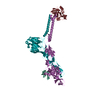
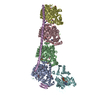
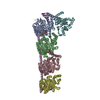




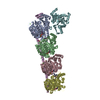
 PDBj
PDBj